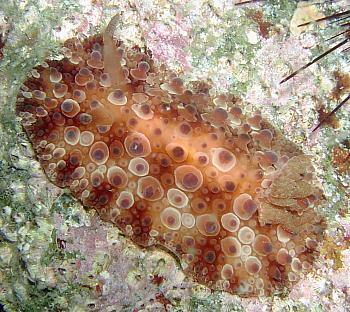
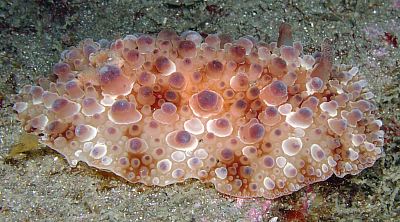
Hoplodoris armata
(Baba, 1993)
Order: NUDIBRANCHIA
Suborder: DORIDINA
Superfamily: EUDORIDOIDEA
Family: Dorididae
DISTRIBUTION
Knnown from Japan and South Korea
PHOTO
Osezaki, Izu Peninsula, Suruga Bay, Japan. Upper: 6m. 11 May 2002, approx 100mm long. Lower: 24m. 18 May 2002, approx 80mm long. Photos:
Nishina Masayoshi & Jun Imamoto
Large ovate dorid with broad mantle skirt. The mantle is covered with rounded tubercles of varying sizes. The tubercles have a rather characteristic shape with a rounded terminal knob, then a narrower waist and then a basal stalk which itself widens to about twice the width of the 'waist' at its base. The background colour of the mantle is a translucent watery brown with scattered dark brown patches. I some animals the patches coalesce so that much of the background is a dark reddish brown. The tubercles usually have a dark purplish knob, while the basal stalk is a translucent watery brown, often with an opaque white ring around the base. Species of Carminodoris are characterised by the possession of jaws, denticulate outer radular teeth, a large prostate gland, and an armed penis. C. armata lacks the denticulate radular teeth but its name armata refers to its penis which is armed with many hooks. See Carminodoris bifurcata.
See generic review of Hoplodoris synonymising Carminodoris with Hoplodoris. Changed on Forum - 24 Oct 2003
References:
• Baba, K. (1993): Two new species of Carminodoris (Nudibranchia: Dorididae) from Japan. Venus, The Japanese Journal of Malacology, 52(3): 223-234. (Figs 1-10, Pl.1.)
• Fahey, S. J. & Gosliner, T. M. (2003) Mistaken identities: On the Discodorididae genera Hoplodoris Bergh, 1880 and Carminodoris Bergh, 1889 (Opisthobranchia, Nudibranchia). Proceedings of the California Academy of Sciences, 54(10): 169-208.
Rudman, W.B., 2003 (March 10) Hoplodoris armata (Baba, 1993). [In] Sea Slug Forum. Australian Museum, Sydney. Available from http://www.seaslugforum.net/find/carmarma
Related messages
Hoplodoris armata? from South Africa
October 19, 2009
From: Valda Fraser
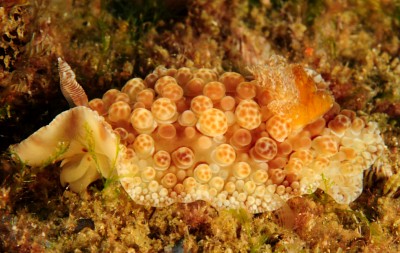

Dear Bill
This one has me stumped. Hope you can solve the ID issue.
Locality: Cape Vidal, 28 m, KwaZulu-Natal, South Africa, Indian, 17 September 2009, On a wreck. Length: 45 mm. Photographer: Valda Fraser.
All the best.
Valda Fraser
valdafraser@mweb.co.za
Fraser, V.J., 2009 (Oct 19) Hoplodoris armata? from South Africa. [Message in] Sea Slug Forum. Australian Museum, Sydney. Available from http://www.seaslugforum.net/find/22684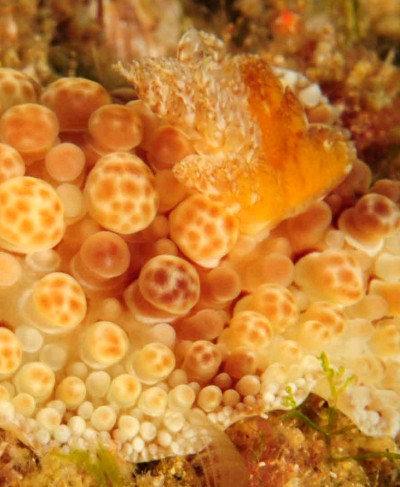
Dear Valda,
It looks a bit like some of the large species of Dendrodoris, but I am pretty sure it is a species of Hoplodoris. Unfortunately I am not finding that genus very easy to identify to the species level from external appearances, but the shape of the tubercles, with a prominent stalk and a basal white ring, suggest this is a colour form - or close relative of - Hoplodoris armata, which if verified would give the species a huge range extension from Japan and the western Pacific. Interestingly, Fahey & Gosliner (2003) in their revision of the genus considered Carminodoris mauritiana (from Mauritius) to be a synonym of H. grandiflora. But they did note there were differences in the reproductive system between Bergh's description for C. mauritiana and their dissections of animals they identified as H. grandiflora. Since they had no specimens of H. armata to study in their revision it still leaves open the possibility that Carminodoris mauritiana is a very old name from H. armata. Unfortunately nothing is ever simple.
Have you seen this animal often? It would be good to get an idea of colour variability.
Best wishes,
Bill Rudman
Re: Hoplodoris sp? from Townsville, QLD
September 12, 2008
From: Melanie Wood
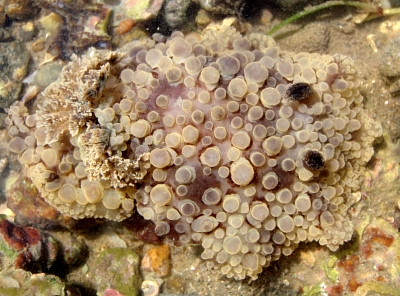
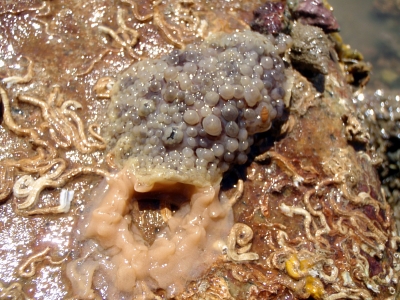
Concerning message #21191:
Hello again,
Well, I was just down at my usual haunt and came across this one again, with egg masses! I saw 3 egg masses on the rock with this one and another 4 on various other rocks. I was excited and hope that it may aid in confirming the species in this area. From what I have been told by a lecturer at James Cook University, I believe Gillian Brodie may have been working on one of these species, but I am not sure.
Locality: Rowes Bay, Low tide, exposed, Queensland, Australia, 16 May 2008, Intertidal muddy. Length: 7 cm. Photographer: Melanie Wood.
I also have some more photos of the egg masses as well as the underside of this specimen if needed.
I do have a question, I was wondering if any work has been done on the toxins for these guys? There was quite a strong odor near this one and I later had a reaction, with my hand swelling, after picking this one up (in my infinite wisdom).
Thank you again
Mel
gizmel@yahoo.com
Wood, M. J., 2008 (Sep 12) Re: Hoplodoris sp? from Townsville, QLD. [Message in] Sea Slug Forum. Australian Museum, Sydney. Available from http://www.seaslugforum.net/find/21579
Dear Mel,
Gillianne Brodie was working on species of Dendrodoris so I suspect the species your lecturer was referring to was Dendrodoris denisoni which can look quite similar. I am pretty sure this is a species of Hoplodoris and the shape of the pustules on the dorsum - stalked and inflated - make me think this could be Hoplodoris armata as that is the only species with pustules shaped like this.
Concerning your hand swelling, it is possible that this nudibranch feeds on a sponge you may be allergic to. There are a number of sponges which cause some people to have allergic reactions. It is also possible the allergy was a response to toxins being produced by bacteria or other primitive organisms living symbiotically with the sponge. Another possibility is there was a nasty cnidarian or polychaete worm nearby which you touched inadvertently. Anything is possible in tropical waters but thankfully for all us, bad things rarely happen. It would be very difficult to study things in detail if we had to wear safety clothing all the time.
Best wishes,
Bill Rudman
Hoplodoris armata? in Perth West Australia
July 13, 2006
From: Tom Davis
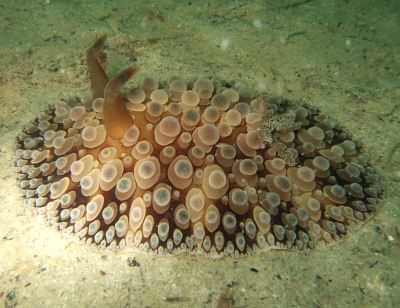
Hi Bill
We have seen a large nudibranch a couple of times that we have been unable to identify from the books we have. The nudibranch looks like Hoplodoris armata?. We have seen two colour variants and I would appreciate it if you could help with their identification.
Upper Photo: Approx. 12 cm in length. Spotted at Rockingham wreck dive trail, Rockingham, Perth, West Australia on 15 April 2006 in 11 m of water.
Lower Photo: Approx. 8 cm in length. Spotted at BHP jetty, Naval Base, Perth, West Australia on 26 December 2005 in 7 m of water
Locality: Cockburn Sound, Perth, 7 m and 11 m, West Australia, Indian Ocean, 26 December 2005 and 15 April 2006, Silty bottom. Length: 8 cm and 12 cm. Photographer: Nicola Davis.
Both sites are in the Cockburn Sound which also has major berths for the Port of Fremantle. Could the Nudibranchs have come from Japan/Korea in ballast water?
Tom Davis
tom.davis@worleyparsons.com

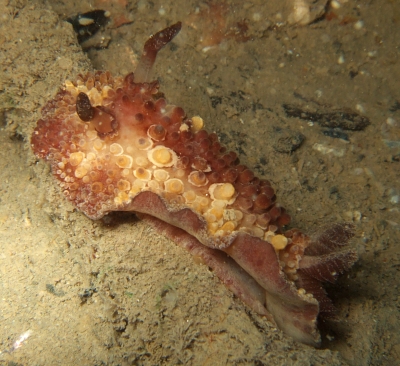
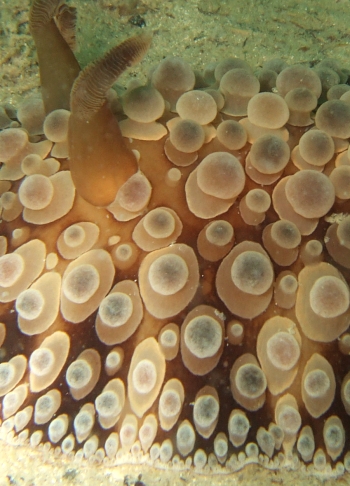
Dear Tom,
They certainly look like a species of Hoplodoris, and certainly if they were from the northeast Pacific I would have no difficulty in identifying them as H. armata from their colour pattern, shape, and size. I would appreciate some feedback from anyone familiar with living H. armata.
If they are this species it is a worrying development, for as you suggest, it would probably mean they have arrived in ballast water. While they may not cause environmental problems, it would be unlikely that they were the only larvae to arrive, and as we know from Tasmania and Port Phillip, Victoria, Australian waters have proved fertile territory for a number of invertebrate species which are causing untold damage to the marine environment.
Best wishes,
Bill Rudman
Carminodoris armata & eggs from Sth Korea
March 28, 2003
From: Dong Bum, Koh
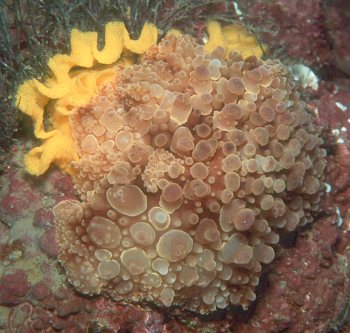
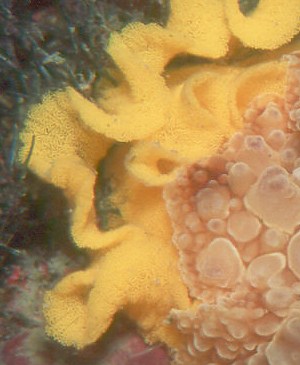
Dear Bill,
Thanks a lot for your comments on Carminodoris armata. Fortunately,I had taken these photos on 9 March 2003 at Moon islet in Jeju.
[NOTE: Roman spelling of name is changed Cheju to Jeju:]
It looks like Carminodoris armata with its egg bands.
W/temperature: 14 degrees (Lowest W/T in Moon area during a year)
Depth: 13m
Photo: Dong Bum, Koh
Best regards,
Dong Bum
drkoh@seasee.co.kr
Koh, D.B., 2003 (Mar 28) Carminodoris armata & eggs from Sth Korea. [Message in] Sea Slug Forum. Australian Museum, Sydney. Available from http://www.seaslugforum.net/find/9433Thanks Dong Bum,
Your egg ribbon looks identical to that of animals from Japan in Tomohiko Kurihara's message.
Bill Rudman
Carminodoris armata from Japan
March 15, 2003
From: Tomohiko Kurihara
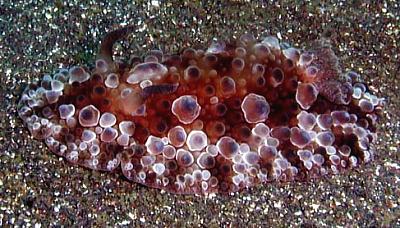
Dear Bill,
I saw your message about Carminodoris armata? from South Korea. So here is some information about C.armata from Japan.
C.armata is common species at Osezaki, Izu-peninsula, Japan. It was seen in spring to early summer. It is mostly active only at night.
Photos: Upper: Length 120mm; Depth 15m; at night, diving; April 2002. Lower Left: Late spring is mating season. I saw this couple and some egg-masses while night diving in May 2002. Lower Right: Juvenile, Length 15mm; Depth 12m; at night, diving; July 2002.
Best wishes,
Tomohiko Kurihara
miyamoto@info.email.ne.jp
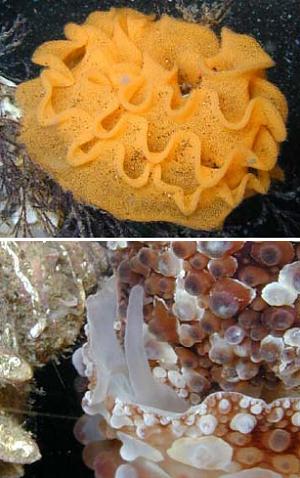
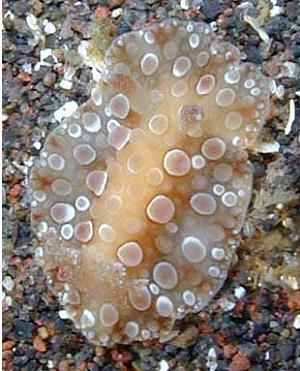
Dear Tomohiko,
Sorry it has taken a while to post these interesting photos. It is good to clarify the identity of this common Japanese animal. It is strange that Baba did not name this animal until 1993.
Best wishes,
Bill Rudman
Carminodoris armata? from Japan
March 15, 2003
From: Nishina Masayoshi & Jun Imamoto


Dear Bill,
Following your comments about Carminodoris armata from Korea, here is some information about it from Japan. This animal is externally similar to Dendrodoris denisoni (Angas, 1864). I don't have Baba's original description, but C. armata doesn't have the brilliant blue patches on the dorsum.
Usually I find D. denisoni in rocky places but C. armata is on the sand. This animal is rather common here in Izu Peninsula, and is particularly abundant by
night scuba diving in spring.
Photos: Osezaki, Izu Peninsula, Suruga Bay, Japan. Upper: 6m. 11 May 2002, approx 100mm long. Water temperature: 19C degrees. Lower: 24m. 18 May 2002, approx 80mm long. Water temperature: 20C degrees. Photos: Nishina Masayoshi & Jun Imamoto.
Best Regards,
Nishina Masayoshi & Jun Imamoto
http://umiushi.zive.net/
imamoto@wips.co.jp
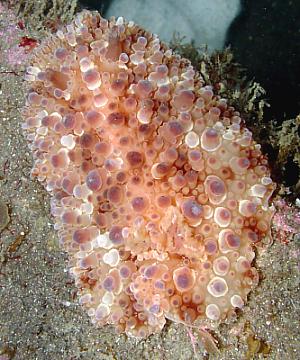
Dear Nishina & Jun,
Thanks for these photos and information. Sorry it has taken a while to post your message. It certainly matches Dong Bum's photos from South Korea.
Best wishes,
Bill Rudman
Carminodoris armata from South Korea
March 15, 2003
From: Dong Bum, Koh
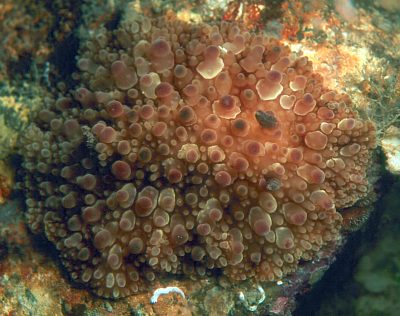
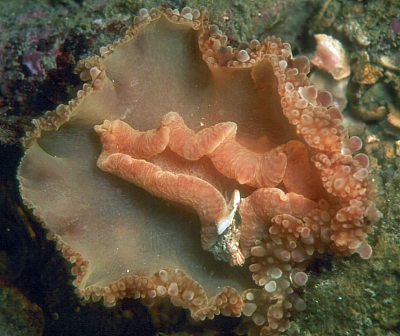
Dear Bill,
I took two photos on 9 February 2003, depth 13m in Moon Islet, Cheju Island, Sth Korea. W/Temperature: 15 degrees
It looks like the same species in my previous message.
I'll be happy if it will be useful in your Forum.
Best regards,
Dong Bum, Koh
drkoh@seasee.co.kr
Koh, D.B., 2003 (Mar 15) Carminodoris armata from South Korea. [Message in] Sea Slug Forum. Australian Museum, Sydney. Available from http://www.seaslugforum.net/find/9214Thanks Domg Bum,
You will see from the two messages from Japan that your animal is indeed Carminodoris armata.
Best wishes,
Bill Rudman
Carminodoris armata? from South Korea
October 24, 2002
From: Dong Bum, Koh

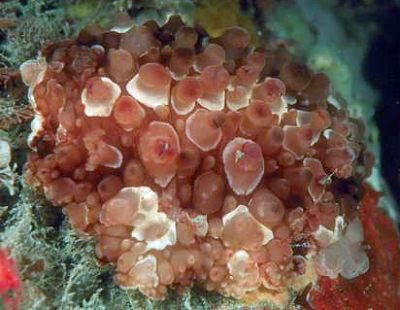
Dear Bill,
Thanks a lot for your earlier advice. Are the animals in the attached photos related to Dendrodoris carbunculosa perhaps?
Upper: Northern coast of Che Ju island. Sth Korea. 16 m depth. at night diving. Sept. 1997
Lower: Mun islet. Che Ju island. Sth Korea. 8 m depth. Oct. 2001
PHOTOS: Dong Bum, Koh
Best wishes,
Dong Bum, Koh
drkoh@seasee.co.kr
Koh, D.B., 2002 (Oct 24) Carminodoris armata? from South Korea. [Message in] Sea Slug Forum. Australian Museum, Sydney. Available from http://www.seaslugforum.net/find/7662Dear Dong Bum,
The tuberculate mantle certainly has similarities to some species of Dendrodoris, but the tubercles around the edge of the rhinophore pocket make me think this is probably not a dendrodorid. There are a number of 'warty' dorids like this from parts of the Indo-West Pacific, and it is rather difficult to separate them without a look at their internal anatomy. Dr Baba (1993) described a species, Carminodoris armata, which from the written description looks much like your animal. However I have never seen a photo of this animal alive so my knowledge of it is very limited. If someone has a photo of Japanese specimens of this species they would be a welcome addition to the Forum.
• Baba, K. (1993): Two new species of Carminodoris (Nudibranchia: Dorididae) from Japan. Venus, The Japanese Journal of Malacology, 52(3): 223-234. (Figs 1-10, Pl.1.)
Best wishes,
Bill Rudman
